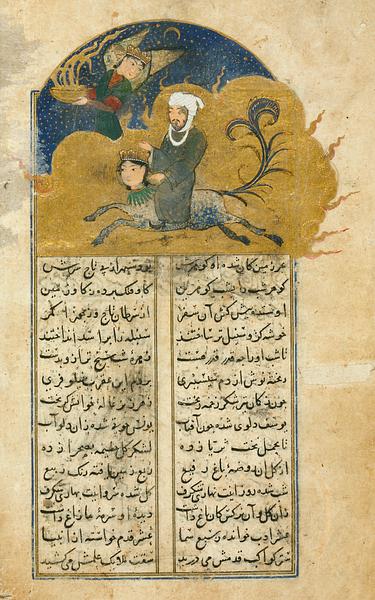A copy of Nizami’s Makhzan al-asrar, the first book in his Khamsa. Copied by Mir Ali ibn al-Yasi al-Tabrizi al-Bawargi
Western Iran; 20th of Jumada al-awwal 790 H = 27th of May 1388
Each leaf: 18.6 × 12.3 cm
This frontispiece painting introduces a copy of the first book in the Persian poet Nizami’s Khamsa (Quintet).
The motif is the Prophet Muhammad’s mystical ascension to heaven (miraj) on the winged horse Buraq, accompanied by the archangel Gabriel.
Normally the Prophet Muhammad is depicted with his face veiled, out of respect for his holy person. In the 14th century, during the Mongol Il-Khanid dynasty and their successors and under the Timurids, however, the Prophet’s face is shown several times – a phenomenon that is also found in later, vernacular art.
Inv. no. 20/2008
Published in:
Sotheby’s, London, 9/4-2008, lot 30;
Thomas Hoffmann: ”Profetens bevisbyrde” in Bibliana, 1, 2010, p. 44;
Eleanor Sims: “The Nahj al-Faradis of Sultan Abu Sa’id ibn Sultan Muhammad ibn Mirranshah: an illustrated Timurid ascension text of the “Interim” period” in Journal of the David Collection, 4, 2014, fig. 5;
Karin Rührdanz: “Visualizing encounters on the road to Paradise” in Sebastian Günther, Todd Lawson (eds.): Roads to Paradise: eschatology and concepts of the Hereafter in Islam, Leiden 2016, vol. 2, fig. 47.3, p. 1049;
Kjeld von Folsach, Joachim Meyer: The Human Figure in Islamic Art – Holy Men, Princes, and Commoners, The David Collection, Copenhagen 2017, cat.no. 26;
Johanne Louise Christiansen: “Det ensomme bæst: Koranens manglende monstre,” Bibliana, 1, 2019 [Online];
Polina Ignatova: ““The Little Flash of Lightning”: Buraq in Islamic art”, EPOCH Magazine, 2020, 1;

